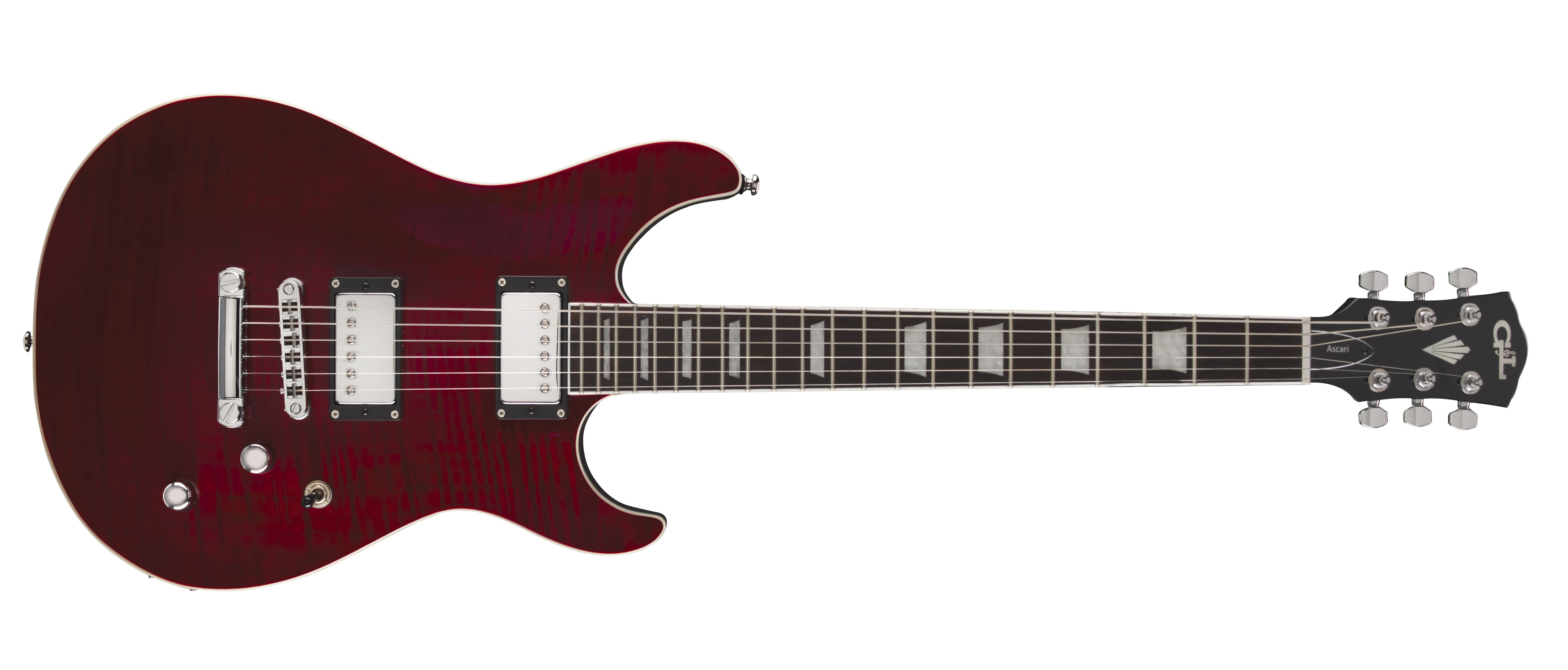Review: G&L Tribute Series Fiorano GTS and Ascari GTS

Streamlined, dual-cutaway axes with three-on-a-side tuners are among the most popular of today’s guitar styles and considered by many to be the modern archetype of rock and metal guitar construction. As it happens, the basics of this design may have originated in the mind of the late, great Leo Fender. A 1980 drawing, recently discovered in Leo’s preserved laboratory, details just such a guitar design as rendered by Leo and G&L cofounder George Fullerton. Dubbed the G-100, the guitar was never developed.
To bring this guitar to life, G&L enlisted the assistance of metal guitar guru, Grover Jackson. He and G&L vice president of engineering Paul Gagon transformed the original sketch into fraternal twins of sorts: the more traditional Ascari GTS and the somewhat sleeker, metal-esque Fiorano. Although Leo drew the G-100 with a bolt-on neck in mind, Gagon and Grover decided to update the two instruments to set-neck construction. Grover’s specific influence is further evident in the sharp visual lines and the low-strung action that beckons players to fly across the relatively flat 12-inch radiused fretboards. Best of all, these new classics are part of G&L’s Tribute Series, making their unique tones and historic pedigree available to guitarists on a budget.
FIORANO GTS
The Fiorano is aptly named after the famous Italian proving grounds where exotic Italian sports cars are pushed to their limits. The guitar’s wide, deep cutaways are both striking and functional, allowing the hand and forearm unfettered access to the screaming top registers. The mahogany neck features G&L’s slim C profile (it feels like a rounded D shape) and a 25 1/2–inch scale, allowing maximum string punch and power as well as space for the 24-fret fingerboard. The broad neck shape makes for ergonomic chording, but speed players will also appreciate how their thumb sits on the neck’s flat hill.
The carved, flamed-maple top ensures that the Gagon-designed humbuckers are elevated to the ideal height, while the remainder of the mahogany body is properly thin. The scorching pickups are intended for players who prefer heinous levels of gain and may want to detune into the bowels of metal’s wicked abyss. A three-way switch selects the pickups, the tone pot can be pulled to tap the pickups’ output, and the volume knob is easily reached for swells. TonePros’ famous bridge maintains superior string balance, even with heavy strings.
PERFORMANCE
Aside from its beautifully loud acoustic response, the Fiorano generates a midrange-forward tone that’s essential for players who want to cut through a heavy mix. The leveled neck hill, acoustic volume and large frets make the guitar incredibly responsive for pile-driving hammer-ons and crisp legato runs. While the pickups clean up well, they shine brightest when asked to sustain long bends, scream out pinch harmonics and define heavily distorted chords.
Get The Pick Newsletter
All the latest guitar news, interviews, lessons, reviews, deals and more, direct to your inbox!
ASCARI GTS
- The Ascari is only slightly more subdued than its shred-happy sister ax, but several details endow it with a sweeter tonal personality and a slinkier feel. First, it’s built on a 24 3/4–inch scale and topped with 22 frets. This shorter scale warms the highs and lows while it reduces overall string tension. Its traditional-style length also means cutaways on the maple-capped mahogany body are less deep, yet you still have the great upper-fret access. As on the Fiorano, the slim C neck profile allows speed and thumb-over-board comfort.
- The pair of covered, Gagon-designed pickups are voiced for rock, country and blues, genres that require full-bodied tones with clean and dirty amp settings. The tone pot pulls up to tap the pickups’ output, and the volume knob is positioned behind the three-position pickup switch so that it doesn’t interfere with strumming. The TonePros bridge assembly adds considerably to the string stability and overtones.
PERFORMANCE
Like the Fiorano, the Ascari is incredibly loud when strummed acoustically. It has the more scooped midrange that you’d expect from a 24 3/4–inch-scale plank and a more relaxed presence across the spectrum. The pickups do a fine job of translating this openness to an amp, maintaining the huge dynamic potentials and touch sensitivity. Through a crunchy amp, the tones are best described as vocal and raucous, singing with a raspy upper midrange, transient lows and pleasantly bright highs.
THE BOTTOM LINE
Whether you want the traditional beauty and smoother tones of the short-scale Ascari GTS or the hot power and speed of the Fiorano GTS, these lightweight and responsive guitars are fitting tributes to an almost-lost Leo Fender design.
“What blew me away was that everyone wanted the curly maple top. People were calling, saying, ‘I’ve got to have the bird inlays’”: Paul Reed Smith on raising the Standard 24, finally cracking the noise-free guitar and why John Sykes is a tone hero
“It combines unique aesthetics with modern playability and impressive tone, creating a Firebird unlike any I’ve had the pleasure of playing before”: Gibson Firebird Platypus review




![[from left] George Harrison with his Gretsch Country Gentleman, Norman Harris of Norman's Rare Guitars holds a gold-top Les Paul, John Fogerty with his legendary 1969 Rickenbacker](https://cdn.mos.cms.futurecdn.net/TuH3nuhn9etqjdn5sy4ntW.jpg)





